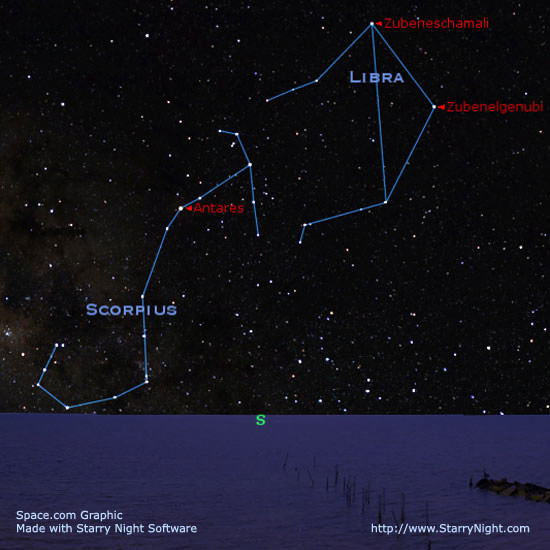
Last week we spoke of the ecliptic, that mysterious line inthe sky along which the sun, moon and planets seem to move. It has been calledby other names such as "the Road of the Sun." The constellationsalong the ecliptic are called the "zodiac."
Of the twelve zodiacal constellations, Libra is the onlystar pattern that does not represent a person or an animal.
Is it Lee-bra or Lī-bra?
Many years ago, one of the long-time lecturers at New York's Hayden Planetarium reprimanded me after I had given a sky show and pointed outLibra to my audience:
"Listen," he said, "the correctpronunciation is "Lī-bra," not "Lee-bra." Remember,you go to a lī-brary, not a lee-brary!"
I initially did not believe him, especially since I knewthat the word library had its origins from the Latin word "libraria"(meaning book), while Libra was Latin for "balance," hence twototally different things. But when I returned home and did some checking, I foundthat the World Book Encyclopedia (Field Enterprises Educational Corporation)indeed suggested the pronunciation LY-bruh, while The American HeritageDictionary of the English Language (Houghton Mifflin Company) deems bothLī and Lē as acceptable.
Now, whenever I look at Libra, I always think of my formerHayden colleague and in deference to him, stress the Lī.
Get the Space.com Newsletter
Breaking space news, the latest updates on rocket launches, skywatching events and more!
Out of balance
Known as "The Scales" or "The Balance," Libra is marked by anoblong figure of stars and owes its importance only to its position in thezodiac. It supposedly consists of a beam with two pans hanging from it, forweighing things.
The load in the right-hand pan must be heavier, for thebalance is tilted down on that side. Libra was once associated with theconstellation Virgo, as the scales of the goddess of Justice which that figurewas supposed to represent.
Just to the east (left) of Libra on these early Juneevenings, the most beautiful zodiacal constellation can be found emerging intoview low in the southeast sky: Scorpius, the Scorpion. Scorpions have two largeclaws in front, but this one seems to have had his claws clipped. In fact, theclaws were indeed cut off to form Libra. A few thousand years ago, Romansdecided that there should be 12 constellations in the zodiac, instead of11, so they made the two claws of Scorpius into the arms of Libra, the Balance.
Libra was also known as "the Claws" of Scorpius,the Scorpion, to the poet Aratus and others of classical times. In fact, two ofLibra's stars still bear the Arabic names, Zubeneschamali and Zubenelgenubi,meaning respectively, "Northern Claw" and "Southern Claw."Zubeneschamali also has a very faint greenish tinge: the only green naked-eyestar.
A fishhook and cat's eyes
The whole figure of the Scorpion is a magnificent sight —sort of a "celestial fishhook" — and is best appreciated now in adark sky without any interference from bright moonlight. It really looks like ahuge scorpion, with its long stinging tail curled over its back. I should pointout here that the currently accepted name of this constellation is Scorpius,not Scorpio.
Principally astrologers (and some older astronomy books)use the latter for labeling the zodiacal sign of that name.
One star clearly outshines the others, with a fiery tingeseemingly emphasizing the Scorpion's sinister appearance. That's Antares, theso-called "rivalof Mars," "Ares" being Greek for Mars. Antares is a supergiant, 700times the sun's diameter, over 9,000 times as luminous and located 604 lightyears away. And lastly, the stars Shaula and Lesath are a close pair of starsin the Scorpion's stinger. Astronomy popularizer Hans A. Rey (1898-1977)christened these stars the "Cat's Eyes," noting, "You will findthe name quite fitting."
Joe Rao serves as an instructor and guest lecturer at New York's Hayden Planetarium. He writes about astronomy for The New York Times and otherpublications, and he is also an on-camera meteorologist for News 12 Westchester, New York.
- Constellations at SPACE.com
- Gallery: Zodiac Constellations
- The Scales and the Scorpion
Join our Space Forums to keep talking space on the latest missions, night sky and more! And if you have a news tip, correction or comment, let us know at: community@space.com.

Joe Rao is Space.com's skywatching columnist, as well as a veteran meteorologist and eclipse chaser who also serves as an instructor and guest lecturer at New York's Hayden Planetarium. He writes about astronomy for Natural History magazine, Sky & Telescope and other publications. Joe is an 8-time Emmy-nominated meteorologist who served the Putnam Valley region of New York for over 21 years. You can find him on Twitter and YouTube tracking lunar and solar eclipses, meteor showers and more. To find out Joe's latest project, visit him on Twitter.









